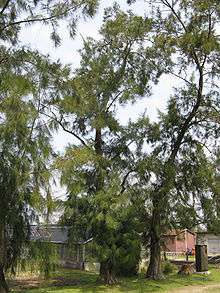Allocasuarina verticillata
| Allocasuarina verticillata | |
|---|---|
 | |
| Scientific classification | |
| Kingdom: | Plantae |
| (unranked): | Angiosperms |
| (unranked): | Eudicots |
| (unranked): | Rosids |
| Order: | Fagales |
| Family: | Casuarinaceae |
| Genus: | Allocasuarina |
| Species: | A. verticillata |
| Binomial name | |
| Allocasuarina verticillata (Lam.) L.A.S.Johnson | |
| Synonyms | |
Allocasuarina verticillata, commonly known as drooping she-oak or drooping sheoak, is a nitrogen fixing native tree of southeastern Australia.[2][3] Originally collected in Tasmania and described as Casuarina verticillata by French naturalist Jean-Baptiste Lamarck in 1786, it was moved to its current genus in 1982 by Australian botanist Lawrie Johnson.[4]
It grows as a small tree with a rounded habit, reaching 4–10 metres (12–35 ft) in height.
The species occurs in Australian Capital Territory, New South Wales, South Australia, Tasmania, and Victoria.[4]
On Kangaroo Island, it is the preferred food item of the Glossy Black Cockatoo, which holds the cones in its foot and shreds them with its powerful bill before removing the seeds with its tongue.[5]
| Wikimedia Commons has media related to Allocasuarina verticillata. |
References
- 1 2 "Synonyms of drooping she-oak (Allocasuarina verticillata)". Encyclopedia of Life. Retrieved 2014-04-05.
- ↑ "Common names for drooping she-oak (Allocasuarina verticillata)". Encyclopedia of Life. Retrieved 2014-04-05.
- ↑ "Allocasuarina verticillata". Retrieved 2008-10-26.
- 1 2 "Allocasuarina littoralis (Salisb.) L.A.S.Johnson". Australian Plant Name Index. Australian National Botanic Gardens. Retrieved 2014-03-29.
- ↑ Crowley, GM; Garnett S (2001). "Food value and tree selection by Glossy Black-Cockatoos Calyptorhynchus lathami". Austral Ecology. 26 (1): 116–26. doi:10.1046/j.1442-9993.2001.01093.x.